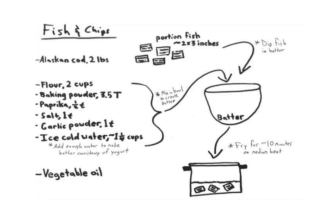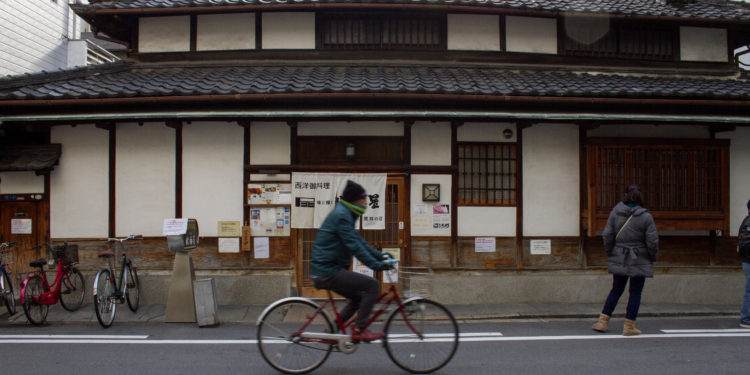
By Tom Godfrey
My wife and I sneak down a side street in Osaka. It is quiet here–a contrast from the main drag that huddles around Tonbori River. The road is full of cafes, the occasional cyclist, and a handful of traditional buildings with wooden accents that seem to belong to another time. One of those buildings is the original branch of the restaurant, Hokkyokusei, where to eat omurice.
I am on a culinary pilgrimage with my wife, SiEun. Our mecca is not a Michelin-starred restaurant but a tried-and-true dining spot that’s been around since the early 1920s and is responsible for an Asian comfort food found all over the world.
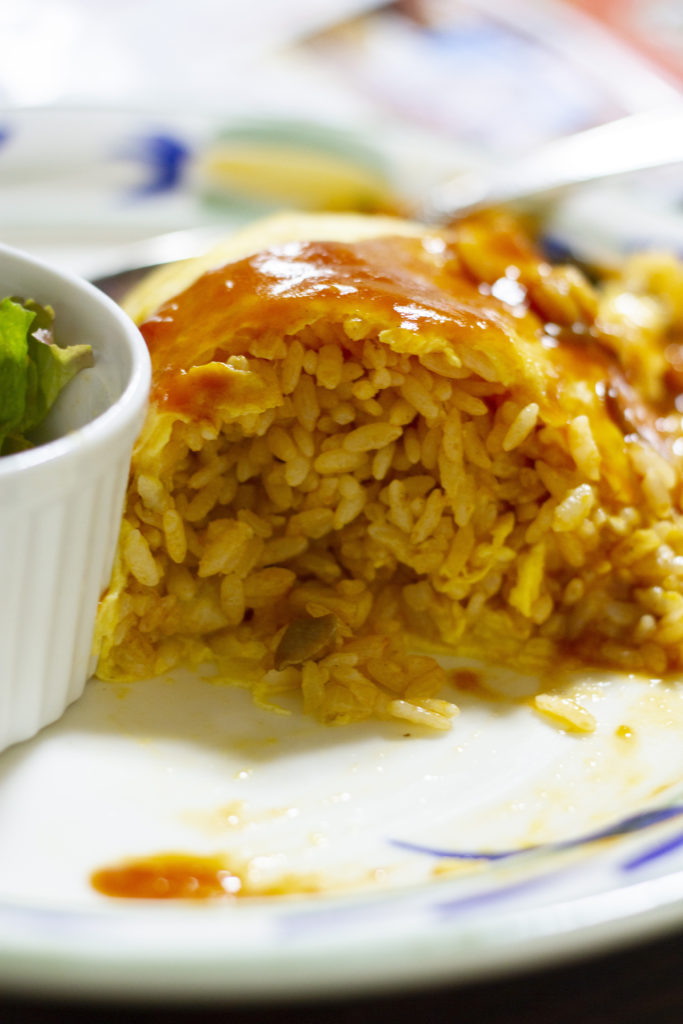
How to Eat
Years ago I arrived in South Korea as a naïve, unprepared and, frankly, horrified English teacher. The longest that I had ever spent away from my home in New England was a week. When I landed and made my way to the city of Cheongju to begin my contract, I experienced the loss of stability that comes with travel.
Travel forces you to relearn things, even simple things like eating. While abroad we begin to communicate with charades and order food by pointing to pictures. Then, after some time, we learn a few words to improve our quality of life. Without fail, our first few words include food.
I had been living off tteokbokki (a spicy rice cake snack) for the first few days because there happened to be a giant picture of it on the wall of the diner near my apartment. After a week, I was sick of tteokbokki. I wanted the peace that comes with eating a good meal and turning off the anxiety that can build in your brain when you’re in a new place.
I opened the door to the diner and belted out the words that my coworker had taught me. I was hoping for a pork cutlet and rice. The woman behind the register smiled and looked at me, confused. Behind the counter, another woman popped up and stared. The glow of kitchen flames flickered on grease-stained tile and lit her face. I smiled like a dumb puppy and repeated what I had said, followed by “rice,”–it was my only strategy.
“Omurice!” said an old wrinkled man sitting on a stool eating soup. He grinned, amused at the situation.
“Yes,” I said, completely oblivious to what I was getting. I looked to the man and he gave me a thumbs up.
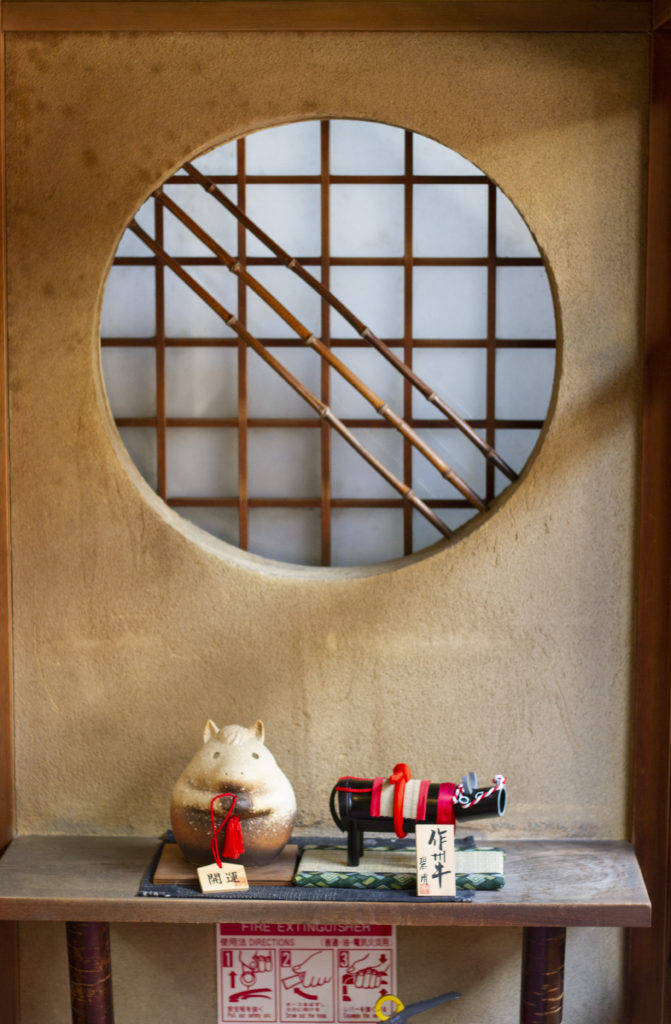
I carried the food to my one-room apartment in the ugliest building in my neighborhood. It was deteriorating and waiting to be replaced by the modern hi-rises that were taking over South Korea. I had only a bed and a broken TV so I sat on the floor and used a small stool as a table. I was doing everything that I could to stave off the wave of homesickness that I knew was starting to crash down on me.
I peeled the plastic wrap from the bowl of omurice. It was rice, fried with vegetables and bits of ham; rice covered in a sheet of yellow egg and smothered in ketchup.
I took a tentative spoonful at first, worried that the blanket of egg might be hiding a tentacle or some other body part that was beyond my ability to cope with at that fragile moment. It was a contradiction that was both familiar yet distinctly not from home. It was greasy in the most delicious and comforting sort of way. It was sweet and tangy. It was full of soft rice and a few crunchy vegetables and salty ham. It was delicious, and I felt it lift me out of my same-meal-everyday funk.
Over the next few weeks, as I began to settle down, omurice became my first go-to food that I could order anywhere. It was filling and was full of ingredients and tastes that I knew in a country full of things that I didn’t understand. It gave me comfort and reliability. Omurice is meatloaf in an American family. It is chicken parmesan, Salisbury steak, and American chop-suey. It is working class at its purest because it’s quick to make, tastes good, and leaves your belly full.
As weeks turned to months and a one-year contract turned into five years, most of my expat friends moved on from the foods we ate during those first clueless weeks. The more complex flavors of the region were discovered and those meals eaten on a lonely floor in an empty apartment were forgotten. Despite broadening tastes, I would pop over to my diner at least once a month and have a meal alone. Almost always it was omurice.
Where to Eat Omurice
Many people credit the chef at Hokkyokusei in the 1920s as the author of omurice’s origin story. Like any important food, there are alternate versions. In this story, omurice was born out of a caring attitude and Japanese hospitality. A regular customer at the restaurant had stomach issues. Each day he ordered rice and a simple omelette because that was what he could handle. The chef created omurice so that the man could eat something tasty without getting sick. He fried some chicken and rice and wrapped the pile in an egg with some sauce. Simple, really.
Today, omurice is everywhere and serves an important role in the diets of people across Asia. Some places serve it with ketchup, some with demi-glace or some other simple sauce. Sometimes the egg is firm, sometimes it is fluffy and soft–splitting open and running down the sides when the top is cut.
It is crowded inside of Hokkyokusei when SiEun and I open the dark wooden door. Locals and tourists bounce around in a small waiting room with a wall of wooden lockers in which to put shoes. Many of the tourists, we notice, are Korean. In Korea, blogs have become a vital part of travel and tourism. All of the information we found about Hokkyokusei was found on Korean blogs. We are all on the same pilgrimage.
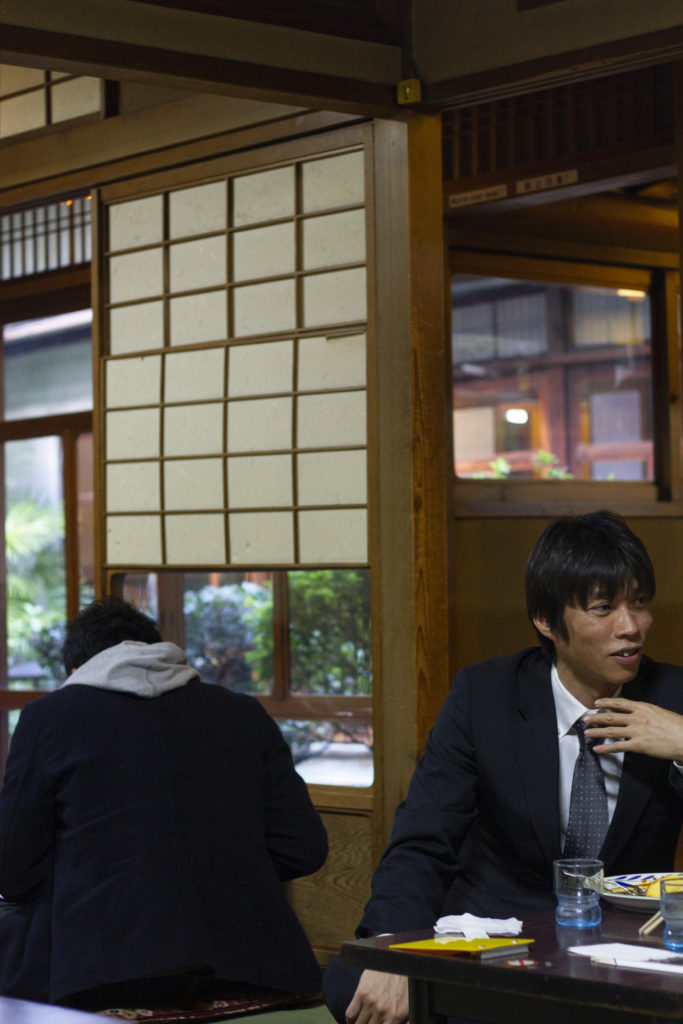
An old man points us down a narrow hallway, past a Zen garden full of powdery white sand, smooth rocks, and twisted bonsai trees. We pass over creaking and groaning floors and through sliding paper doors. We take our seats on the floor at a small table for two.
There is a warmth to the place that I wasn’t expecting. Soft light streams through large windows on a cloudy day. We can hear the lunch break conversations of local workers and the happy chatter of our fellow tourists. It’s the day after Christmas and strings of lights twinkle here and there. The room is simple but comfortable.
There are two main types of omurice that you can order and neither involve the ketchup that I had come to expect in Korea. I order the original: omurice in a thin demi-glace sauce, a few pieces of fried chicken, and miso soup. SiEun orders the fish roe omurice that replaces the fried chicken with fish roe and the brown demi-glace with a pastel pink sauce that looks like strawberry milkshake.
The first spoonful brings me right back to that first meal on my apartment floor. Oily rice, runny egg, and a simple sauce. The demi-glace is richer than ketchup but the essence is the same. It is hearty, filling, and satisfying, if not sophisticated.
The fried chicken is lukewarm, soaked in grease, and tough. This is fine, though. I’m not here for the chicken.
We eat quickly like everyone else. Table turnover is necessarily fast and the service also fast. Shortly after we are finished we are out and into the Osaka streets and back to the controlled chaos of neon, music, and the throngs of people enjoying the day.
Why Eat Omurice?
Of all the meals that I eat in Osaka, omurice holds the biggest place in my mind because it reaffirmed something universal. All of the tourists who made their way to that particular restaurant were not looking for some glamorous food. They were there because they knew what omurice was. People go to fancy restaurants for the experience, for the luxury, and for escape. Omurice can’t be those things. Omurice is something cooked by mothers as kids and to eat in greasy restaurants when you want something comforting. It is nothing more than what it is and nothing less.
Hokkyokusei is located at 2 Chome-7-27 Nishishinsaibashi, Chuo Ward, Osaka, 542-0086, Japan.
Tom Godfrey is a writer and photographer with a heavy focus on communities and travel. His work has appeared in publications and exhibits around the world. His hobbies include eating his wife’s homemade Korean food and riding his bicycle very slowly. He is currently based in New England. You can follow him on Instagram at @tomgods.
If you enjoy this piece, you may enjoy another “EAT” story: Zanzibar’s Spice Dreams.
Do you like stories about Africa?

